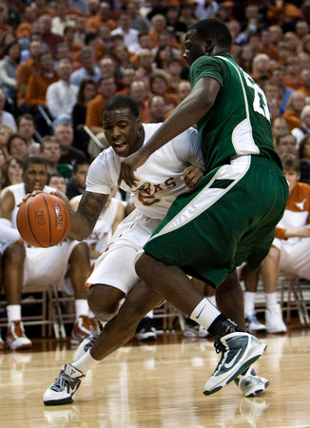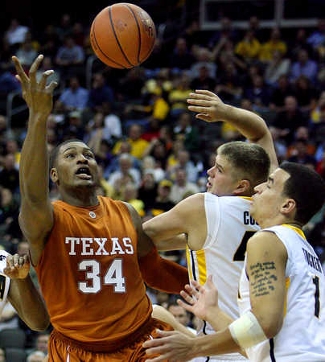| #24/NR Texas Longhorns 87, Oklahoma Sooners 76
With the final regular season game just a few hours away, let’s dive right into our notes from Monday night’s win over Oklahoma…
1) The Longhorns did not fold down the stretch – For a Texas team that has often found itself trailing by large margins during the last two months, it was refreshing to see the Horns respond despite OU’s hot start. The Longhorns were down by thirteen points just eight minutes into the game, thanks in large part to Oklahoma’s 7-of-11 three-point shooting in the first half. But Texas did not fold, and slowly chipped away at the lead. When the Sooners came out strong again in the second half, the Longhorn deficit climbed to eleven once again. But something changed in the team at that point, like their competitive switch had finally been flipped to “on.”
The Texas players really fed off of the crowd down the stretch, with Jordan Hamilton imploring the fans to get louder when OU was forced to take timeouts. J’Covan Brown even taunted the Sooner players by flashing his biceps after he sunk a floater in the lane. While it’s incredibly satisfying to see the team finally wake up and show some fire, the concern is that it seemed like the players needed the crowd energy to do so. The rest of the games this season will be on the road or at “neutral” sites, so the Longhorns have to be able to show that same level of effort and determination when the crowd is not on their side. Chances are very, very good that the fans of the old Big 8 will be rooting against Texas next week in Kansas City, particularly those fans in blue or purple.
2) Backcourt roles were more defined – For the first time in ages, each member of the Texas backcourt seemed to contribute exactly what was required of them. Justin Mason made the start and provided solid defense, along with a few strong, slashing moves to the bucket. Jai Lucas was also in the starting lineup, and although he ultimately only played seven minutes, his offensive contribution came the way it needed to. Lucas drained a three in the first half on a simple kickout. He is only a catch-and-shoot guy, so having him play off the ball allowed him to make a small, but useful contribution to the offense, as opposed to forcing him into the point guard role where he is ineffective.
While Avery Bradley had a rough night from the floor, he once again provided solid defense once Texas started rotating and helping. J’Covan Brown was the big story in the backcourt, though, playing 33 minutes off the bench. He showed leadership and poise down the stretch, and his willingness to attack the rim led to 15 points on the night, including a perfect 6-of-6 from the line. If Brown can give that kind of performance the rest of the way, the blow from the loss of Dogus Balbay will be much, much softer.
3) Free throws are improving – For the second-consecutive game, the Longhorns made at least 80% of their attempts from the charity stripe. For much of the season, the team’s average has hovered in the low-to-mid 60% range, so this drastic change is certainly worth noting. While the 6-of-6 line from Brown is not a shocker, seeing Damion James go 8-of-12 and Dexter Pittman sink all four of his attempts is certainly reassuring. Statistically, the two players should be expected to miss more shots this afternoon, as their percentages naturally regress to the mean. But what if they’ve actually been practicing and improving over the last week or so? Then perhaps the physical inside play could finally pay off in the post-season, as the Texas big men actually make the free throws they work so hard to earn.
4) Texas has two offensive identities – Not only did the Longhorns show two different offensive styles on Monday night, but they both actually worked. It was reminiscent of the early part of the season, when Gary Johnson famously said that Texas could “beat you any way you want it.” When the Longhorns can play different styles of basketball with equal success, it makes it incredibly hard for opponents to gameplan and defend. Of course, this is just one game against a team that has struggled all season long. But if this newfound offensive duality can continue this afternoon and into the postseason, there is reason for optimism.
The two offensive looks from Texas differ when it comes to the post presence. In the first look — the traditional one we’ve seen all season — the Longhorns are built around Pittman. The team focuses on getting the ball inside, where the big man is expected to either make a quick move to the basket, or kick it back out to rinse and repeat.
Early in the season, defenses sagged off of Mason and Balbay to create more pressure inside on the big man and deny those entry passes. On Monday night, having a backcourt involving Bradley and Brown meant that the OU defense couldn’t sell out to help inside. In addition, after a rusty start, Pittman finally began to make quick moves with the ball, so the defense didn’t have time to react. If these factors hold as the season winds down, the “big” lineup should be quite effective.
When Dex isn’t on the floor, the Longhorns go with the fiesty Gary Johnson down low. He’s five inches shorter than Pittman, and is versatile enough to mix in a midrange game. That added threat spreads out the floor and allows Brown and Mason to slash to the rim for easy points or to draw the foul and get to the line. Johnson’s ability to pull the defender away from the paint also makes it easier for James to get offensive boards and putbacks. And, of course, the pure hustle and determination that Gary brings to the floor leads to extra possessions and second chance points.
Again, it should be noted that all of this happened against a Oklahoma team that will likely finish in the bottom quarter of the league when today’s game are through. But for once, Texas fans had something to be excited about after Monday’s game. Now, we just must wait and see if those things carry over to a game against a very, very good Baylor team this afternoon.
|












